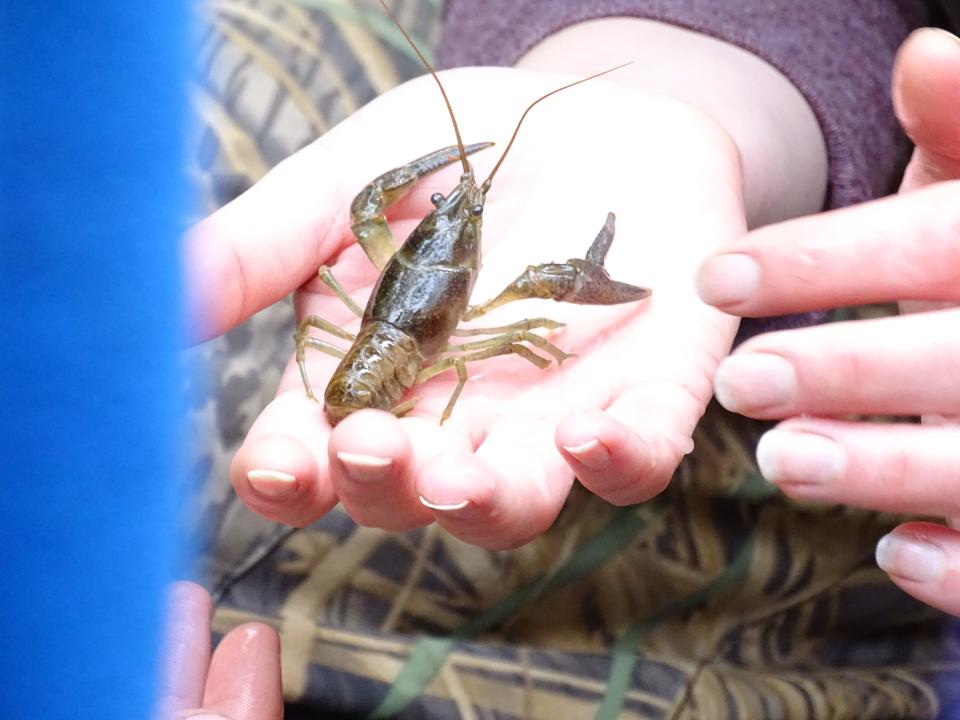Ken Baker: Crayfish are a 200 million industry in U.S.

Mudbugs? Fiddlers? Blue yabbies?
If you waded your first creek in a northern state, you probably know them better as crayfish, but they’ll be crawfish to you if you instead muddied your Red Ball Jets in a southern crick. One way or the other, the term is probably an Anglicization of the French word écrevisse.
Yabbies are Australian and mudbugs was in common use in parts of Louisiana and Eastern Texas until market researchers recommended that crawfish farmers avoid the term as bad for business.
Crawfish farmers?
Each year, more than 80,000 tons of the crustaceans are raised in ponds or caught in traps in the U.S. as part of a $200 million industry, 90% of which is centered in Louisiana. And that’s just in the U.S. Crayfish are on the menu around the world. When we visited Deb’s relatives in Sweden a few years ago, we were honored with a huge platter of kräftor (offered as an appetizer before the freshly caught salmon) that easily could have served as our entire meal.
Scandinavians have caught crayfish in their waters for hundreds of years but these days, most of what’s eaten comes from China and the U.S., a disturbing story that’s being repeated throughout Europe.
Crayfish have an important role in the ecosystem
Crayfish play an important ecological role as a sort of middleman in aquatic ecosystems. Adults of most species are opportunistic feeders on all manner of living and dead plants and algae, while juveniles feed more on aquatic insects, snails and fish eggs. Both forms are primarily active at night, hiding under rocks and debris during the day.They are in turn are fed upon by hundreds of predators, from otters, mink, and raccoons to catfish, loons, and herons. It’s been estimated that where crayfish are abundant, they can constitute up to 75% of the diets for smallmouth bass and bullfrogs.
Of course, humans seek them out too, and that’s where Europe’s problems began. As early as the mid-1800s, overfishing led entrepreneurs to import crayfish from the U.S., especially the red swamp crawfish, our most commonly farmed and eaten species.
Initially found along the coastal gulf plain from the Florida panhandle to Eastern Mexico, it is now found on every continent except Antarctica and Australia (where it’s illegal to even think about importing, keeping or selling them).This and other highly aggressive American crayfish, like the rusty crayfish of Ohio and neighboring states, commonly out-compete native species for food and cover, driving them into open areas where they are more susceptible to predation.
American crayfish plague attacks European crayfish
But just as bad is a disease carried by most American species ominously called crayfish plague. While most of our species are resistant to the disease, European crayfish have proven highly susceptible, dying within a couple of weeks after having contracted it.
So, as we’ve seen with so many other accidental and intentional introductions of species between continents — from house sparrows and emerald ash borers to zebra mussels and Asian carp — it’s a mess.

In 2017, a paper co-authored by researchers from George Washington University and the University of Oxford reported that the world was home to 669 different species of crayfish, about 70% of which can be found in American freshwater habitats, the lion’s share in the streams, rivers, swamps, ponds and lakes of the Southeast.
But even here, habitat destruction caused by dams, pollution and siltation, and the problematic introduction of crayfish from one part of the country to another, have led various states to list 65 species as endangered, threatened, or species of special concern.
Most North American species range in size from one to six inches long, from tip of the outstretched pincers (known as chelipeds to biologists) to the end of the tail. In different regions, you can find crawdads colored in most of the hues of the rainbow, from white, blue or gray to red, brown or yellow.
But like lobsters, when you boil them up, they turn bright red. It was only in 2002 scientists finally figured out why. Crustaceans have a pigment called astaxanthin embedded in their exoskeletons which, left alone, reflects red light. But they also have a protein called crustacyanin that gloms onto astaxanthin, twisting it in such a way that it no longer reflects red.
But drop a lobster, crab or crayfish into boiling water and the heat destroys the crustacyanin but not the astaxanthin pigment. No longer bound up by the protein, it unwinds into a shape that reflects red light.
Now if you’re thinking of hosting your own Louisiana Crawfish boil (and there are plenty of recipes online) you should count on about three pounds of fresh crawfish per guest. But since it’s commonly only the tail that’s cracked open and eaten, and that’s just 15% of the crustacean, that works out to about a half-pound of tail meat per person.
Bon appétit!
Ken Baker is a retired professor of biology and environmental studies. If you have a natural history topic you would like Dr. Baker to consider for an upcoming column, please email your idea to fre-newsdesk@gannett.com.
This article originally appeared on Fremont News-Messenger: Ken Baker: Crayfish are ecologically, economically important

